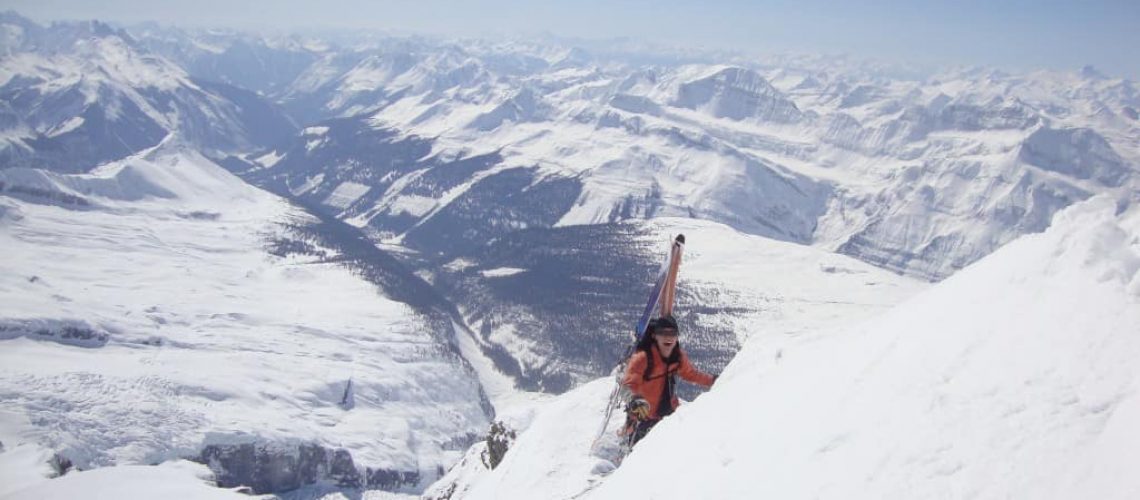
Ski touring, in our opinion, has got to be hands down one of the most incredible ways to experience the mountains in the winter. There is something to be said about moving, slowly and methodically uphill while chatting with your friends, and taking moments to enjoy how incredibly quiet it is. Most often, there isn’t another soul aside from you and your crew in the entire forest!
Additionally, once you reach the alpine, big mountain views loom across the entire valley. Once at the top of the descent line, everyone transitions into downhill mode – skins come off, boots locked down, heels click into place, bindings done up. There are few things in this world as much fun as what you’re about to do. It doesn’t ever get old… wind whistles in your ear. You can hear your buddies hooting and hollering around you and more often than not you find yourself in the white room; one of the most magical feelings in the world.
You don’t have to be an amazing prodigy skier to get into ski touring. If you’re feeling quite confident on blue runs at the ski hill, and have ridden powder successfully, you are good to hit the backcountry. But hold on! There are some things you need to know first. Getting your avalanche training is so much more important than you may realize. It’s not only about your safety but about your friend’s safety as well. If you are the only one left unburied in an incident, you need to know how to react, where to begin, and what to do. Backcountry skiing and splitboarding is the perfect way to explore the mountains in winter while experiencing dreamlike descents. It opens up a world of possibilities, from lift-accessed powder beyond the resort boundaries to multi-day trips at remote lodges and huts, to exploring high peaks and glaciers.
Splitboarding, like it’s sister from another mister ski touring, is a heck of a lot of up to get down. There is something to be said about powering yourself up the mountain, and in comparison to riding resort, riding down is that much sweeter because YOU got yourself there. Additionally, you can power yourself out to zones you previously thought were very far away.
So what’s it like being a splitboarder? Well, for starters, you’ll likely always be the only one in the group who is on a splitboard. Once in a while, you’ll have a pal who is in the same boat as you are, but for the most part, you’ll hear lots of ‘gotta wait for the slowboarder’ or ‘dang slowboarders always holding up the crew’. The way to avoid this is obvious. Get so good at changing over, YOU are waiting for the skiers. Additionally, it should be noted that they are likely deep down very envious of how effortlessly you float down the mountainside and wish they were surfing the pow as well.
Here are our tips to make you faster on the changeover than those pesky skiers:
- Always be the first up or down the mountain. The early bird always gets the worm and that’s the same in this case. If you’re the first one there, you’ll have extra time on the changeover, and you’ll be the one waiting for them. Plus, what’s better than getting the first rip on a fresh slope? Name something… we’ll wait.
- If you ride with a helmet on (which you should be) get yourself a lightweight touring helmet like this one from Petzl. You’ll save yourself time wearing it on the approach, and if something goes awry you know your head will be safe. Not to get too dark here, but a lot of avalanche fatalities are due to blows to the head, so you have more of a fighting chance if your noggin is safe and intact.
- Get into a routine. Like anything, getting into a routine creates muscle memory, and you will methodically go into changing over every time. This will make you faster and more efficient, and soon you’ll be the first one changed over, every time. For us this means collapsing our poles during our last few steps up to our changeover location, taking off our backpack and grabbing our shell and goggles, stepping out of our bindings, taking our bindings off, skins off, stowing poles and skins, putting our board together and voila! We are ready to step into our bindings and go.
- Take snacks you can eat on the skin track. Of course, most of the time you will stop for a lunch break although it depends on who you are with and your objectives for the day. We like to take ample snacks to keep us fuelled the entire trip, rather than just one big lunch break. This will also keep your muscles firing for more of the trip, and will help you avoid fatigue.
- Our biggest tip for you is avoiding flat terrain. Take a look at your line and plan out where you are going. There is nothing worse than getting stuck on flat terrain and having to use your ski friends as your own personal backcountry Uber. Additionally, get good at split-skiing. Sometimes split-skiing out is way more manageable than trying to shimmy your way down.
Backcountry skiing and splitboarding are the perfect way to explore the mountains in winter while experiencing dreamlike descents. It opens up a world of possibilities, from lift-accessed powder beyond the resort boundaries to multi-day trips at remote lodges and huts, to exploring high peaks and glaciers. It’s no wonder that this activity is gaining so much popularity in Western Canada at the moment. Becoming a confident, safe, and successful backcountry skier or boarder requires experience and education though, like anything worth doing! With some patience and determination, along with proper guidance, it can take you to places you never imagined possible.

